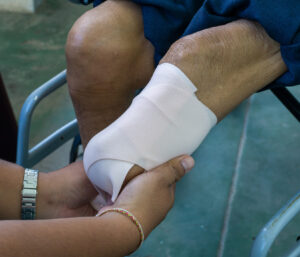Written By: Vern Swanson, DPT, PT, Ph.D., NCS
Tackling Phantom Limb Pain: Eight Strategies Worth Considering
Phantom limb pain (PLP) can be a perplexing and frustrating experience for those who have lost a limb. It often feels like a cruel joke played by the nervous system, with sensations of pain or discomfort in a limb that is no longer there. While there are various interventions available to help manage PLP, it’s essential to recognize that the effectiveness of these treatments can vary, and the research supporting them is often limited. Here, we’ll explore eight interventions for PLP, keeping in mind the mixed evidence surrounding their efficacy. These topics will be covered in much more depth including application in my future Summit CEU course, Phantom Limb Sensation and Pain on Tuesday, December 10th.
- Mirror Therapy
-
- Mirror therapy uses a mirror to create a visual illusion of the missing limb, which can help alleviate pain for some individuals. In practice, the patient places a mirror in front of their intact limb, creating a reflection that simulates the appearance of the missing limb. As the patient moves their intact limb, they see the reflection and perceive it as the missing limb moving as well. This visual feedback can help retrain the brain to alter the perception of pain by creating a sense of ownership over the missing limb. For many, engaging in this therapy can lead to a reduction in the intensity of phantom sensations and pain. However, research on its effectiveness is mixed, and not everyone experiences relief from this approach. Some individuals may find it helpful, while others may feel frustrated if they do not achieve the desired results.
- Transcutaneous Electrical Nerve Stimulation (TENS)
-
- TENS therapy involves applying electrical impulses through the skin to relieve pain. While some studies suggest it may help manage PLP, the results are not universally consistent, and more research is needed to establish its effectiveness.
- Mind-Body Interventions
-
- Mindfulness, meditation, and guided imagery are strategies that can promote relaxation and help manage pain perception. Kinesthetic mindfulness techniques have displayed mixed results in the literature base. While these techniques have shown promise, the evidence supporting their specific effectiveness for PLP is still developing.
- Acupuncture
-
- Acupuncture involves inserting needles into specific points on the body to alleviate pain. While some individuals report anecdotal positive outcomes, the research on acupuncture for PLP is inconclusive, and results may vary widely.
- Physical Therapy
-
- Physical therapy focuses on exercises and rehabilitation to improve function and potentially reduce pain. While many patients find benefit from physical therapy, the evidence supporting its direct effectiveness for PLP is still limited.
- Virtual Reality Therapy
-
- Virtual reality therapy immerses patients in a digital environment that helps them visualize their missing limb. While some studies suggest it may provide relief, the research base is still developing, and it may not be effective for everyone.
- Platelet-Rich Plasma (PRP) Injections
-
- PRP therapy involves injecting a concentration of platelets derived from the patient’s own blood into the affected area. The procedure begins with drawing a small amount of blood from the patient, which is then processed in a centrifuge to separate the platelets from other components. This concentrated solution, rich in growth factors, is then injected into the site where pain is experienced, aiming to promote healing and reduce inflammation. While some small studies have shown promise for PRP in various pain conditions, the evidence supporting its specific effectiveness for PLP is limited and requires further investigation.
- Massage Therapy
-
- Often used to promote relaxation and relieve tension, massage therapy may help alleviate discomfort associated with PLP. While research on its direct effectiveness for this specific condition is limited, many patients find it beneficial for overall well-being.
In Conclusion
Phantom limb pain can be a challenging condition to manage, and while various interventions are available, the research supporting their effectiveness is often inconsistent and sometimes limited. A combination of strategies may yield the best results, addressing not only the physical aspects of pain but also the emotional and psychological factors involved. The course will explore the effect of combining interventions can have on your patients with phantom limb pain. CLICK HERE to view Vern Swanson’s Instructor Page.
CLICK HERE to view Vern Swanson’s Instructor Page.
Vern’s Upcoming Live Webinar CE Courses:
November 12th: 6:00-8:00PM EST
Reducing Fall Risk in the Older Adult Population
December 10th: 6:00-8:00PM EST
Phantom Limb Sensation and Pain
Vern’s On-Demand Video CE Courses:
Fall Risk Reduction Strategies in Lower Extremity Amputee
Reducing Fall Risk in the Older Adult Population
About Summit Professional Education
Summit equips Physical Therapists, Occupational Therapists and SLPs with better continuing education courses that provide CEUs while impacting patient outcomes. Find high-quality on-demand CE along with the largest offering of live options — including live webinars, live streams, and in-person courses. Want to deep dive on a topic? Summit offers hundreds of 6-hour courses for the most in-depth learning!
